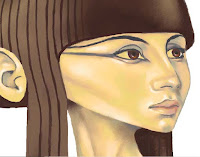I swore the arms would be done this week, and they are, just about. All flight systems are on line and she's taxiing on to the runway - well, hopping would probably be a better description. Hopping because she has legs and feet, as well as arms. And as you can see from the picture at the top of the page, she has eyes as well.
As usual I began the arms on a separate layer, which was just as well as I've had to cut them up, and rotate them, and bits of them, and move them slightly back and forth over the shoulder region trying to decide what looked right. And rub out parts of them and redraw and repaint gaps, and cut areas and generally curse and swear. Was it worth it? Hmmm, that's debatable.
As I said last week, I decided to have her holding a box instead of a scroll, because I thought that a scroll of the type I envisaged would be awkward and would obscure parts of the arms and chest of the bird. And you have to be able to see that she's a bird with arms. Both arms would also have to be pretty extended so I could show that she was unrolling a large scroll. My sketches weren't promising.
 |
| Arms above the basic lines. Note the gap at the right elbow where I cut it and rotated the forearm. |
 |
| Seeing the arms with the rest of the colour layers. Still no hands. |
 |
| First hand in, and look at that box - it's slipped down the layer tree so its now under the hair! I'll have to drag it up again. |
 |
| The finished arms. That box is a bit plain, it could do with some hieroglyphics or something. |
 |
| The finished Ba bird - with added shadow. Hah ha - sparrowlegs! |
So there it is. The trouble with too many Ba birds is that the feathers get up your nose. Something else for next week I think.
My website
My Zazzle Page















